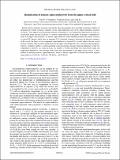| dc.contributor.author | Venderbos, Joern Willem Friedrich | |
| dc.contributor.author | Kozii, Vladyslav | |
| dc.contributor.author | Fu, Liang | |
| dc.date.accessioned | 2016-10-19T20:00:45Z | |
| dc.date.available | 2016-10-19T20:00:45Z | |
| dc.date.issued | 2016-09 | |
| dc.date.submitted | 2016-08 | |
| dc.identifier.issn | 1098-0121 | |
| dc.identifier.issn | 1550-235X | |
| dc.identifier.uri | http://hdl.handle.net/1721.1/104866 | |
| dc.description.abstract | Recent nuclear magnetic resonance and specific heat measurements have provided concurring evidence of spontaneously broken rotational symmetry in the superconducting state of the doped topological insulator Cu[subscript x]Bi[subscript 2]Se[subscript 3]. This suggests that the pairing symmetry corresponds to a two-dimensional representation of the D[subscript 3d] crystal point group, and that Cu[subscript x]Bi[subscript 2]Se[subscript 3] is a nematic superconductor. In this paper, we present a comprehensive study of the upper critical field H[subscript c2] of nematic superconductors within Ginzburg-Landau (GL) theory. Contrary to typical GL theories which have an emergent U(1) rotational symmetry obscuring the discrete symmetry of the crystal, the theory of two-component superconductors in trigonal D[subscript 3d] crystals reflects the true crystal rotation symmetry. This has direct implications for the upper critical field. First, H[subscript c2] of trigonal superconductors with D[subscript 3d] symmetry exhibits a sixfold anisotropy in the basal plane. Second, when the degeneracy of the two components is lifted by, e.g., uniaxial strain, H[subscript c2] exhibits a twofold anisotropy with characteristic angle and temperature dependence. Our thorough study shows that measurement of the upper critical field is a direct method of detecting nematic superconductivity, which is directly applicable to recently-discovered trigonal superconductors Cu[subscript xBi[subscript 2Se[subscript 3], Sr[subscript x]Bi[subscript 2]Se[subscript 3], Nb[subscript x]Bi[subscript 2]Se[subscript 3], and Tl[subscript x]Bi[subscript 2]Te[subscript 3]. | en_US |
| dc.description.sponsorship | David & Lucile Packard Foundation | en_US |
| dc.description.sponsorship | United States. Department of Energy. Office of Basic Energy Science. Division of Materials Sciences and Engineering. (Award No. DESC0010526) | en_US |
| dc.description.sponsorship | Netherlands Organization for Scientific Research (Rubicon grant) | en_US |
| dc.publisher | American Physical Society | en_US |
| dc.relation.isversionof | http://dx.doi.org/10.1103/PhysRevB.94.094522 | en_US |
| dc.rights | Article is made available in accordance with the publisher's policy and may be subject to US copyright law. Please refer to the publisher's site for terms of use. | en_US |
| dc.source | American Physical Society | en_US |
| dc.title | Identification of nematic superconductivity from the upper critical field | en_US |
| dc.type | Article | en_US |
| dc.identifier.citation | Venderbos, Jörn W. F., Vladyslav Kozii, and Liang Fu. "Identification of nematic superconductivity from the upper critical field" Physical Review B, vol. 94, 094522, September 2016, pp. 1-7. | en_US |
| dc.contributor.department | Massachusetts Institute of Technology. Department of Physics | en_US |
| dc.contributor.mitauthor | Venderbos, Joern Willem Friedrich | |
| dc.contributor.mitauthor | Kozii, Vladyslav | |
| dc.contributor.mitauthor | Fu, Liang | |
| dc.relation.journal | Physical Review B | en_US |
| dc.eprint.version | Final published version | en_US |
| dc.type.uri | http://purl.org/eprint/type/JournalArticle | en_US |
| eprint.status | http://purl.org/eprint/status/PeerReviewed | en_US |
| dc.date.updated | 2016-09-26T22:00:06Z | |
| dc.language.rfc3066 | en | |
| dc.rights.holder | American Physical Society | |
| dspace.orderedauthors | Venderbos, Jörn W. F.; Kozii, Vladyslav; Fu, Liang | en_US |
| dspace.embargo.terms | N | en_US |
| dc.identifier.orcid | https://orcid.org/0000-0002-0543-6298 | |
| dc.identifier.orcid | https://orcid.org/0000-0002-0695-6500 | |
| dc.identifier.orcid | https://orcid.org/0000-0002-8803-1017 | |
| mit.license | PUBLISHER_POLICY | en_US |
| mit.metadata.status | Complete | |
